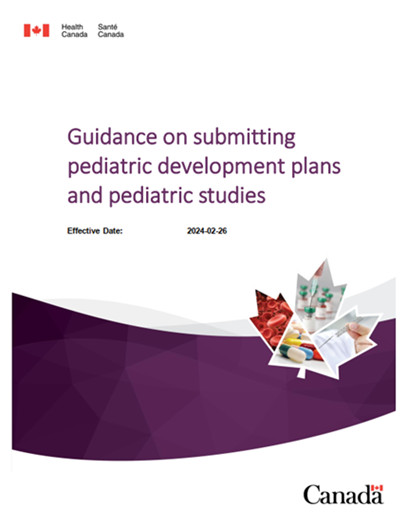Guidance on submitting pediatric development plans and pediatric studies: Overview
Download in PDF format
(712 KB, 32 pages)
Organization: Health Canada
Date published: May 2024
Cat.: H164-362/2024E-PDF
ISBN: 978-0-660-71517-9
Pub.: 240083
On this page
- Purpose
- Background
- Scope and application
- Policy objectives
- Note about guidance documents in general
- Transparency
Purpose
This guidance outlines the policy on submitting a pediatric study. It's intended to help sponsors align their submissions with the policy. The pediatric study submission pilot may be used to inform future policy.
Under this policy, Health Canada will be asking sponsors who file a new drug submission (NDS) and certain supplements to a new drug submission (SNDS) to include a pediatric development plan (PDP) with their submission. The PDP:
- should provide details of any ongoing or planned pediatric studies
- may also include a rationale for not studying the drug in all or part of the pediatric population
The policy takes effect on February 26, 2024.
All studies within the PDP will be expected to be submitted to Health Canada. Those studies, as well as any pediatric data submitted with the original NDS or SNDS, will be reviewed according to existing procedures.
Background
Many medications that are prescribed for children are prescribed off-label. Information and data from clinical trials of drugs in children are essential to support evidence-based pediatric therapies. Without this information, health care providers rely on other sources of clinical and scientific evidence to assess if the benefits of a medication outweigh the risks for a specific patient. Health Canada is taking steps to increase the availability of data that will help health care providers make these important decisions.
International regulators such as the United States Food and Drug Administration (US FDA) and the European Medicines Agency (EMA) have developed legislative and regulatory tools to encourage the:
- study of the safety and efficacy of drugs in pediatric populations and
- submission of findings from those studies to the regulatory agencies
To increase access to safety, efficacy and quality information in pediatric populations and to align with international standards, Health Canada is conducting a pilot of the pediatric study submission policy.
Scope and application
This guidance document applies to certain classes of "drugs", as defined by section 2 of the Food and Drugs Act (act), for human use. It includes the following products:
- pharmaceutical drugs
- includes prescription and non-prescription pharmaceutical drugs
- biologic drugs as set out in Schedule D of the act
- includes biotechnology products, vaccines and fractionated blood products
- radiopharmaceutical drugs as set out in Schedule C of the act
The following products are out of scope for this guidance document:
- disinfectants
- medical devices
- natural health products
- biosimilar biologic drugs
- generic pharmaceutical drugs
- includes prescription and non-prescription pharmaceutical drugs, as well as radiopharmaceuticals
The following submission pathways are out of scope for this guidance document:
- submissions relying on third-party data submission pathway
- submissions based on the administrative submission pathway
Of note, both pharmaceutical and biologic drugs are referred to as a "drug" throughout this guidance document, unless otherwise indicated.
This guidance document applies to submissions filed under Part C, Division 8 of the Food and Drug Regulations (FDR):
- NDS for pharmaceutical and biologic drugs
- SNDS for new indications, new dosage forms and new routes of administration for pharmaceutical and biologic drugs
Pediatric populations for the purposes of this policy includes individuals aged from birth to under 18 years.
Policy objectives
In line with international approaches, the objectives of the pediatric study submission policy are to:
- encourage sponsors to submit, in a timely manner, safety and efficacy information for drugs expected to be used in pediatric populations
- provide more information on the safety, efficacy and dosage of drugs used in pediatric populations to health care providers, patients and their families
Note about guidance documents in general
Guidance documents provide assistance to industry and health care professionals on how to comply with governing statutes and regulations. They also provide guidance to Health Canada staff on how mandates and objectives should be met fairly, consistently and effectively.
Guidance documents are administrative, not legal, instruments. This means that flexibility can be applied. However, to be acceptable, alternate approaches to the principles and practices described in this document must be supported by adequate justification. They should be discussed in advance with the relevant program area to avoid the possible finding that applicable statutory or regulatory requirements have not been met.
As always, Health Canada reserves the right to request information or material, or define conditions not specifically described in this document, to help us adequately assess the safety, efficacy or quality of a drug. Health Canada is committed to ensuring that such requests are justifiable and that decisions are clearly documented.
Transparency
Health Canada will continue to communicate up-to-date information about drugs for human use. The following information is available online:
- Notice of compliance (NOC) database: contains NOCs issued for drugs for human use
- Drug product database: contains information about drug identification numbers (DINs) issued for drugs for human use, including the product monograph
- Drug and Health Product Portal: contains regulatory decision summaries and summary basis of decision documents, which describe Health Canada's rationale for the approval of prescription drugs for human use
- Clinical information portal: contains the clinical information filed by sponsors to seek approval of human drugs under Division 8 of the FDR
